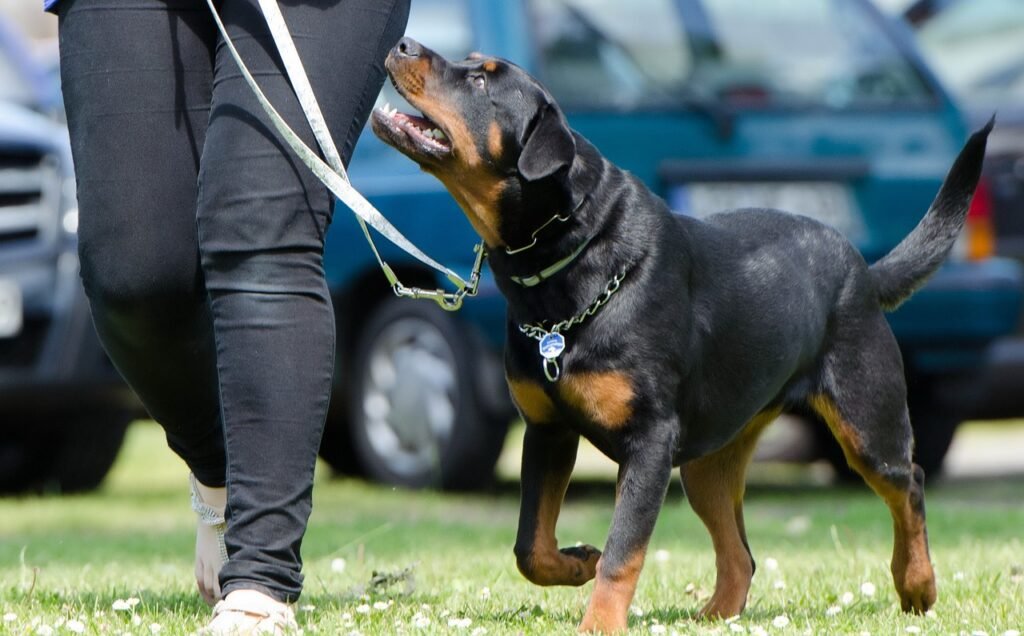Training a dog can be one of the most rewarding experiences, but it can also be a challenge if you’re not familiar with the right techniques.
One of the most effective methods is positive reinforcement.
This dog training guide will walk you through the process, explain why it works, and show you how to apply it to real-life situations.
Whether you’re a first-time dog owner or an experienced handler, there’s something here for everyone.

Why Positive Reinforcement?
Positive reinforcement is a simple concept: Reward your dog when they do something right.
It’s based on the idea that dogs are more likely to repeat behaviors when they’re rewarded.
Think about it like this: When you do something well at work and your boss praises you, it makes you feel good, right?
You’re more motivated to keep doing a great job.
Dogs are the same way.
They thrive on encouragement, and when you reward them with treats, praise, or toys, they’ll want to keep up the good work.
Unlike outdated training methods that rely on punishment, positive reinforcement focuses on rewarding the good, not punishing the bad.
This creates a trusting, happy relationship between you and your dog.
Real-Life Example: How I Trained My Rescue Dog
I remember the first time I tried this method with my rescue dog, Max.
When I first adopted him, he was terrified of everything—especially loud noises.
The first time I used positive reinforcement was during our walks.
Every time we passed a busy street or a barking dog, I gave him a small treat if he remained calm.
At first, he was a bit unsure, but soon he started associating the loud sounds with treats.
Eventually, he became confident walking by other dogs and even traffic.
It wasn’t an overnight process, but the rewards-based approach worked wonders.
This personal experience really drove home for me just how effective positive reinforcement can be.
Getting Started: Tools You’ll Need
Before you dive into training, it’s important to gather some essentials.
You’ll need:
- Treats: Soft, small, and smelly works best. You want your dog to be eager for the reward.
- Clicker (optional): Clicker training pairs a clicking sound with the reward, helping your dog understand exactly what they’re being rewarded for.
- Leash and collar: Keep your dog controlled and safe during training sessions.
You don’t need anything fancy or expensive—just things that your dog finds motivating.
Remember, dogs respond best when training is consistent, so have these tools handy for every session.
Step-by-Step Training Techniques
Start Small: Sit and Stay
The easiest way to introduce positive reinforcement is by teaching basic commands like “sit” and “stay.”
Here’s how I trained Max using positive reinforcement:
- Command: Stand in front of your dog, hold a treat close to their nose, and slowly move it over their head. This will naturally make them sit as they follow the treat with their nose.
- Reward: As soon as they sit, say “Yes!” or use your clicker, and give them the treat.
- Repeat: Practice this several times until they start sitting on command without needing the treat to guide them.
- Stay Command: Once your dog masters “sit,” you can move on to “stay.” After your dog sits, hold your hand up like a stop sign and say, “stay.” Take a few steps back. If your dog doesn’t move, reward them.
By starting with simple commands, you’re laying the foundation for more complex training.
Common Challenges and How to Overcome Them
Positive reinforcement can feel slow at first, and many people get frustrated when their dog doesn’t catch on immediately.
One mistake I made early on was giving up too quickly when Max didn’t respond the way I wanted.
But consistency is key.
If your dog isn’t responding to a command, it might be because:
- The environment is too distracting: Try training in a quieter location and slowly work your way up to busier settings.
- The reward isn’t motivating enough: Experiment with different treats or toys to find what really gets your dog excited.
Dogs are just like people—they have their own preferences and quirks.
Keep experimenting, and don’t get discouraged.
Timing Is Everything
One of the most important things to remember in dog training is that timing matters.
When using positive reinforcement, you need to give the reward immediately after the correct behavior.
If there’s a delay, your dog may not understand what they’re being rewarded for.
For example, if you ask your dog to sit, but you wait too long to give them the treat, they might think they’re being rewarded for standing back up or looking around.
This is where a clicker can come in handy.
By clicking the moment your dog performs the desired action, you’re helping them understand exactly what they did right.
Top Tips for Consistent Results
Here are a few tips that have helped me stay on track with Max’s training:
- Keep sessions short: Dogs have short attention spans. Aim for 10-15 minute training sessions.
- End on a positive note: Always finish training on a high. If your dog seems frustrated, switch to an easy command they know, reward them, and call it a day.
- Practice daily: Repetition is the mother of all learning. Make training part of your daily routine.
- Use high-value rewards for big wins: For tougher commands or situations, use a special treat your dog doesn’t usually get.
When to Seek Professional Help
Sometimes, even with the best dog training guide and techniques, things don’t go as planned.
Maybe your dog has a specific behavioral issue that feels beyond your control.
In these cases, don’t hesitate to seek professional help.
Dog trainers can offer personalized advice and provide an outside perspective.
Whether it’s a local trainer or someone you connect with online, an expert can help you fine-tune your training methods for better results.
Wrapping It Up
Training a dog using positive reinforcement isn’t just about teaching commands; it’s about building trust, creating a bond, and making learning fun.
Whether you’re working on basic commands or tackling more advanced tricks, the reward-based approach works wonders in strengthening your relationship with your dog.
Consistency, patience, and the right tools are the secret ingredients.
So next time you’re out training your dog, remember to keep it positive!





